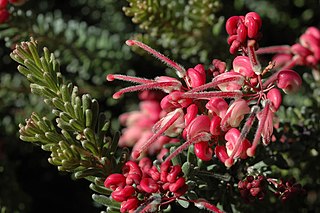
Grevillea lanigera, commonly known as woolly grevillea, is a species of flowering plant in the family Proteaceae and is endemic to south-eastern continental Australia. It is a spreading shrub with narrowly oblong to more or less linear leaves and clusters of pink to red, and cream-coloured flowers.

Pimelea spicata, commonly known as the spiked rice flower, is a flowering plant in the family Thymelaeaceae and is endemic to New South Wales. It is a slender plant with white flowers and elliptic leaves.

Olearia pimeleoides, commonly known as pimelea daisy-bush, is a species of flowering plant in the family Asteraceae and is endemic to southern continental Australia. It is an erect shrub with elliptic, linear or lance-shaped leaves, and white and pale yellow, daisy-like inflorescences.

Pimelea alpina, the alpine rice-flower, is a species of flowering plant in the family Thymelaeaceae and is endemic to south-eastern continental Australia. It is an erect, prostrate or spreading shrub or undershrub with narrowly elliptic leaves crowded at the ends of branches and heads of pinkish red or white flowers.
Grevillea hockingsii is a species of flowering plant in the family Proteaceae and is endemic to south-eastern Queensland. It is an erect shrub with oblong to narrowly elliptic leaves and clusters of reddish-pink flowers.
Grevillea cyranostigma, commonly known as Carnarvon grevillea or green grevillea, is a species of flowering plant in the family Proteaceae and is endemic to the Carnarvon Range and adjacent areas of central Queensland. It is a spreading shrub with woolly-hairy to silky-hairy branchlets, narrowly oblong leaves, and pale green flowers.

Grevillea helmsiae, commonly known as Helms' grevillea, is a species of flowering plant in the family Proteaceae and is endemic to Queensland. It is a shrub or tree with elliptic to narrowly egg-shaped leaves with the narrower end towards the base and small clusters of white to cream-coloured flowers with a green style.

Grevillea humilis is a species of flowering plant in the family Proteaceae and is endemic to eastern New South Wales. It is an erect to spreading shrub with narrowly elliptic to more or less linear leaves, and pink or white flowers.

Pimelea sericea is a species of shrub in the family Thymelaeaceae. It is native to Australia, specifically Tasmania. Their common name is mountain rice flower. Pimelea means fat and sericea means silk. The reason could be that Pimelea species usually have oily seeds and fleshy cotyledon. The sericea came from the fact that they are covered with silky hair.
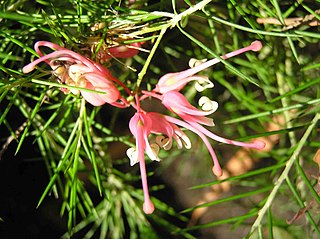
Grevillea deflexa is a species of flowering plant in the family Proteaceae and is endemic to inland areas of central Western Australia. It is a shrub with linear to elliptic or egg-shaped leaves, and groups of red, yellow or red and yellow flowers.
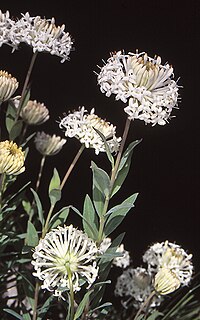
Pimelea treyvaudii, commonly known as grey rice-flower, is a species of shrub in the family Thymelaeaceae. It has white flowers in spherical heads at the end of branches and is endemic to eastern Australia.
Pimelea pagophila, commonly known as the Grampians rice-flower, is a species of shrub in the family Thymelaeaceae. It has a restricted distribution, white flowers in spherical heads at the end of branches, green leaves arranged in opposite pairs and is endemic to Victoria, Australia.

Pimelea aeruginosa is a species of small shrub in the family Thymelaeaceae. It is a small shrub with yellow flowers and is endemic to Western Australia.

Pimelea ammocharis is a species of small shrub in the family Thymelaeaceae. It is a small shrub with white-yellow to orange flowers and is endemic to Western Australia.

Pimelea curviflora, also known as curved rice-flower is a shrub in the family Thymelaeaceae and is endemic to Australia. It is a small, hairy shrub with greenish-yellow or red tubular flowers.
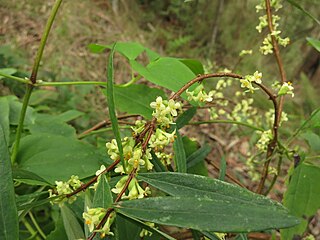
Pimelea axiflora, commonly known as bootlace bush, is a small shrub in the family Thymelaeaceae and is endemic to Australia. It is a small shrub with whitish flowers on mostly smooth stems.
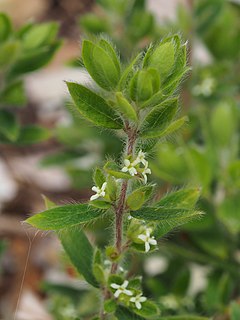
Pimelea venosa, commonly known as Bolivia Hill rice-flower, is a flowering plant in the family Thymelaeaceae and is endemic to a restricted area of New South Wales. It is an erect shrub with densely long-hairy stems and leaves, elliptic to lance-shaped leaves and small groups of white flowers.
Hibbertia mulligana is a species of flowering plant in the family Dilleniaceae and is endemic to north-eastern Queensland. It is a sub-shrub with narrow elliptic leaves and yellow flowers with 70 to 74 stamens arranged around three densely hairy carpels.
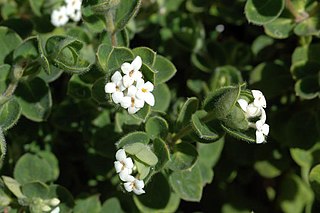
Pimelea altior is a species of flowering plant in the family Thymelaeaceae and is endemic to eastern Australia. It is a shrub with elliptic leaves and heads of white, tube-shaped flowers.
Pimelea approximans is a species of flowering plant in the family Thymelaeaceae and is endemic to northern Queensland. It is a perennial shrub with elliptic leaves and spikes of hairy, yellow, tube-shaped flowers.















